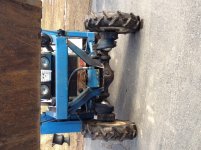I'm not the tractor police, so everyone do what they want on this.

Since you asked for opinions, here is mine.
Look in the tractor manual. If, like my New Holland compact and most every other compact tractor - and every ag tractor with a loader attached -, they advise not to do this, I would _not_ do this.
There is a thread somewhere on this site showing a tractor with the front axle busted. Not a pretty sight, and sounding expensive to fix.
If one looks at the photo, one sees that the tire is now a full tire widh wider with the tire like this. That is a lot of extension, a lot more stress on the knuckle, which is in a ways on the axle. You didn't trade the stress from inner to outer - you about doubled it. With a loader on the tractor, there is already a lot of stress on those knuckles. You are about doubling the stress they are getting.
Not a good thing.
Then, what are you gaining? a front axle pivots on the centerline of the tractor. Widening the front axle like this offers _very_ little gain to stability. The tractor will still pivot up near the radiator, don't see where you gained anything in stability.
The rear axle - now that is where you gain a lot of sability by widening it, and most compact tractors allow you to widen them out in various configurations. Go ahead and widen the rears.
Then, what helps stability even more than wider axles, is weight on the rear tires. Fill those rears with fluid, and you will have a very stable tractor. Can do wheel weights, but fluid is lower center of gravity & helps stability more.
The front axle, you added a whole lot of stress to the mechanism, while gaining practically nothing in stability because it pivots anyhow. The axle might last fine with it wider, but - why take the chance? Didn't gain anything for the risk involved.
That is my opinion.
--->Paul


